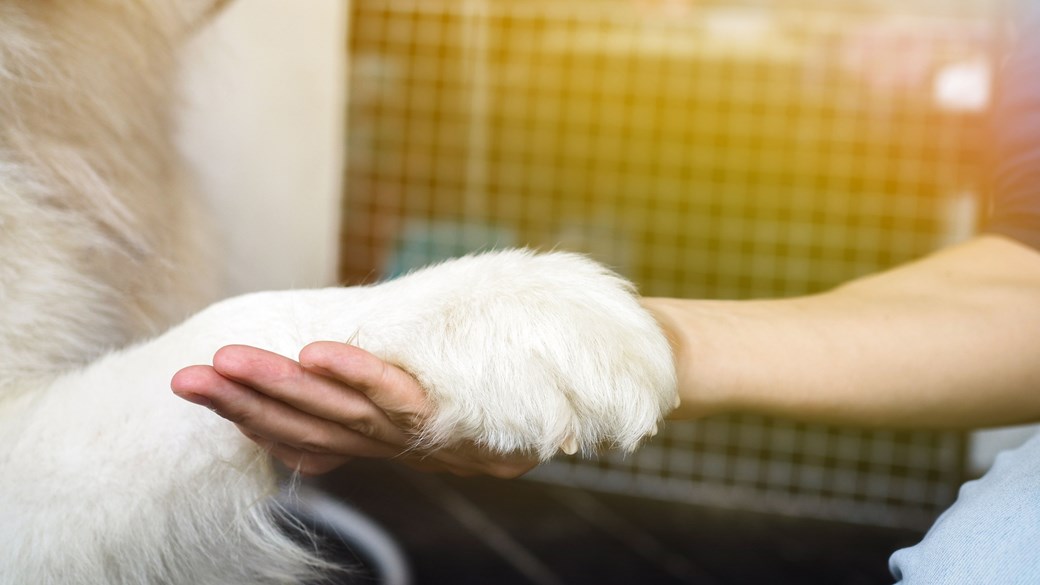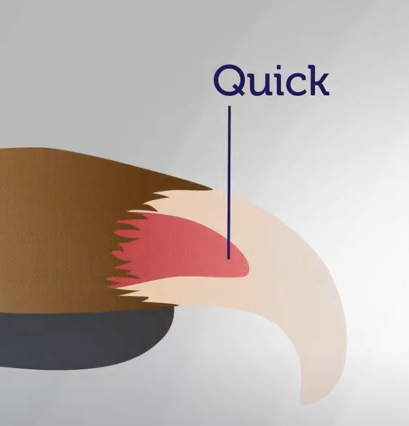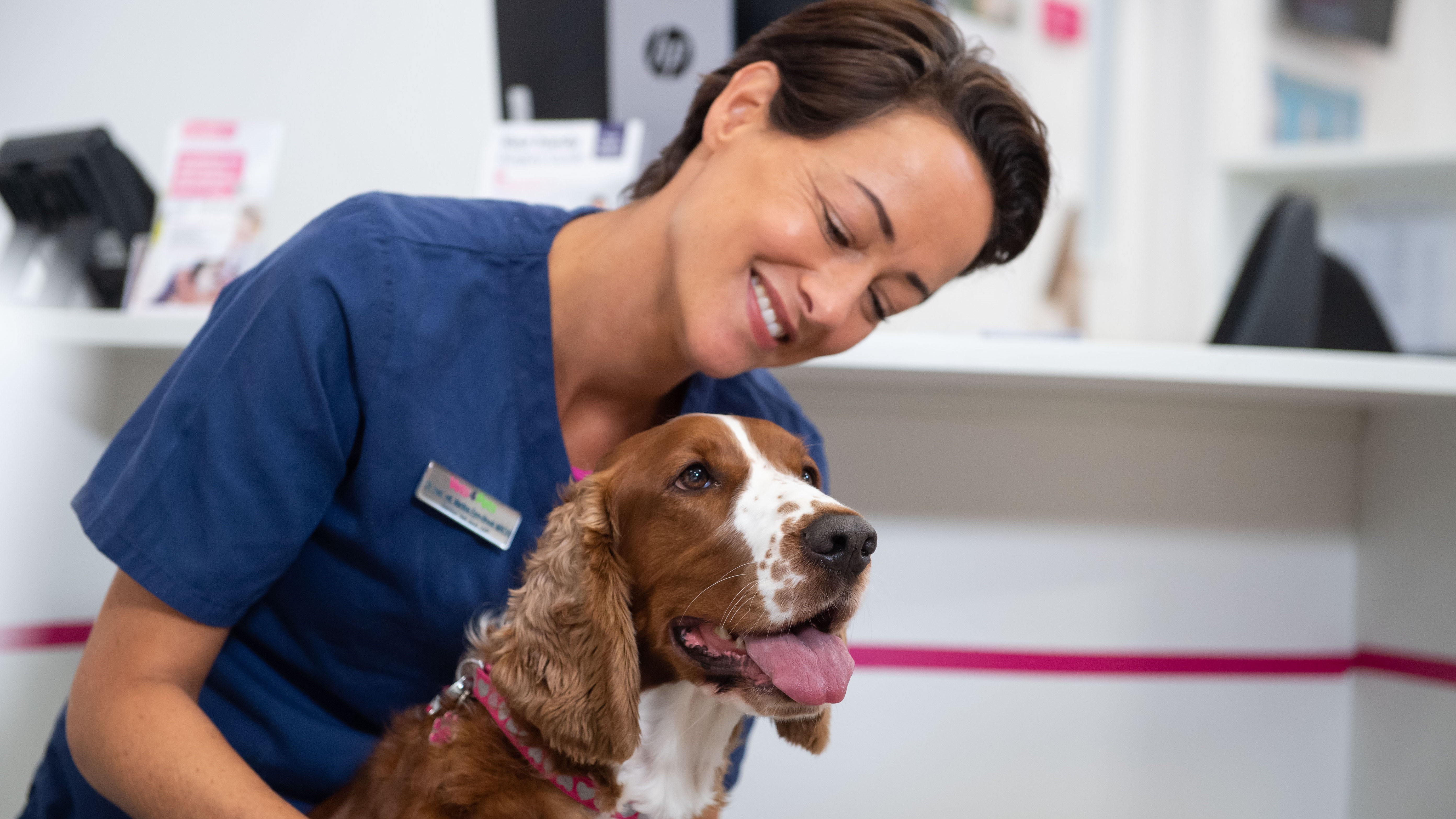
How to cut a dog's nails
While many dogs will never need to have a nail trim because they lead an active lifestyle and their nails wear down naturally, some dogs will need help to keep their nails to a healthy length and shape.
Dogs’ nails help to provide traction when running and protect the toes while digging. Breed variation and medical conditions sometimes mean that a dog will need a regular nail trim. If your dog falls into this category, chat with your vet team to discuss how often their nails should be trimmed. Doing so will help prevent nails from causing discomfort or from interfering with the normal functioning of your dog’s paws and legs.
You may prefer your dog’s groomer or vet team to clip your dog’s nails but, if you’d like nail trimming to be performed regularly before nails have become long or, if your dog gets worried about being taken for a nail trim, we’ll show you how to do it yourself.
What tools do I need for cutting dogs’ nails?
You’ll need some pet nail clippers of the right size for your dog’s nails. Your vet team or groomer will be able to advise you on the correct size of trimmers for your dog.
Some dogs who don’t cope with having their nails trimmed using clippers, may be happier if you use a nail file or sanding block regularly to wear down the nails instead.
If you’re planning to trim your dog’s nails by yourself, you might also consider getting a caustic pencil so that, should the worst happen and you make a nail bleed, you can use the pencil to stop the bleeding.
How to cut a dog’s nails
- First, away from your dog, practice how to hold and use your dog’s nail clippers.
- When you’re ready to clip your dog’s nails, have some high-value treats ready. Sit or stand your dog on the floor or, if your dog is very small or you are more comfortable standing up, place them on a non-slip surface where you can handle them easily. You might need to ask someone to help, to ensure your dog doesn’t fall off. You’ll need good lighting so that you can see the nails clearly.
- Lift up one paw at a time, so you’re looking at the underside. Using your thumb on the pad of the toe and your forefinger to support the furry side of the toe at the base of the nail, squeeze gently to straighten the tip of the toe and extend the nail properly.
- If you can see clearly where the quick finishes, you should be able to trim the nail tip confidently. If you can’t see the quick, you’ll need to nibble away at the nail until you are happy with the shape, stopping if you see the centre of the cut surface changing colour to pink or red, as this is the sensitive quick coming into view.
- When you clip, it will be more comfortable for your dog if the nail isn’t squeezed around the quick. With this in mind, rotate the clippers so that the blades cut from the top to the bottom surfaces of the nail, rather than from side to side. You might be able to take the tip off a nail in one clean cut, but if not, you can nibble off little slivers and work your way around it that way.
- Every so often, let your dog’s foot down so you can check to see whether you need to trim any further. Aim to have the finished nail so that its tip does not touch the ground when your dog is standing squarely.
How long should dogs’ nails be?
When working out how short to cut your dog’s nails, first, you’ll need to understand how normal nails should function.
When a dog stands squarely on level ground, the pads on their toes and feet should all be in contact with the ground, but the nails should not. When a dog’s nails touch something, including the ground, they send signals via the nerves to the brain. Repeated signals from nails in contact with the ground can lead to altered weightbearing, shifting the dog’s weight towards their hind end, which isn’t great for the rest of the dog’s body. Nails should still be long enough to give traction when running and turning and they should still protect the ends of the toes when digging.
Dew claws help dogs to turn. They can be at risk of overgrowing, so you’ll need to keep an eye on them. Like the other nails, they should be worn or trimmed to a length just beyond that of their quick and shouldn’t curl around.
Some breeds of dog have hind dew claws as well as front ones, and these are often only loosely attached by skin, with no bony attachments connecting them to the limb. These can become long and curly if they’re left alone and they often get caught and torn so, if your dog has hind dew claws, you may need to trim these more often than other nails. Your vet team can advise you on the options for management of hind dew claws.
FAQs
 The quick of a nail is the living, inner part that lies up the middle of the nail. It contains nerves and a blood supply and it’s joined directly to the toe. The quick looks like a small, pink, pointed triangle. You can see the quick inside a white nail if you hold your dog’s paw up to the light, but you can’t see the quick in a black nail. The quick gets longer as a nail grows longer and as a nail wears down, the quick gradually recedes and gets shorter.
The quick of a nail is the living, inner part that lies up the middle of the nail. It contains nerves and a blood supply and it’s joined directly to the toe. The quick looks like a small, pink, pointed triangle. You can see the quick inside a white nail if you hold your dog’s paw up to the light, but you can’t see the quick in a black nail. The quick gets longer as a nail grows longer and as a nail wears down, the quick gradually recedes and gets shorter.
Sometimes, a nail might break or get pulled off, leaving the quick exposed. This will feel sore and sensitive for a couple of weeks and it might bleed if it gets knocked or scratched. It will dry up and recede towards the base of the nail, but it’ll remain vulnerable until the new nail grows back (which, in most cases, it will), after a few more weeks. Until then, it will need to be kept clean and dry. If it does get knocked and bleed, you can bathe it in cold plain or salty water and apply pressure to it, using your hand or a lightly applied dressing, if it keeps dripping. Usually, a damaged quick will stop bleeding after a few minutes, when normal blood clotting processes are activated. If you’re worried about an exposed or bleeding quick, or a damaged nail, your vet team can advise you further.
Many active dogs will not need to have their nails trimmed, as they’ll wear down their nails naturally. Even the dew claws (found part of the way up the front legs) wear down when the dog performs tight turns. Some breeds, however, even if they are active, may need to have regular nail trims because the shape of their feet prevents their nails from wearing down so easily. Sighthounds, for instance, normally have long toes and their nails point forwards, rather than towards the ground.
Dogs who can’t be exercised normally, perhaps because they’re very elderly or because they’re recovering from a procedure and are resting, might need to have their nails trimmed, since they won’t wear down naturally.
If you do need to trim your dog’s nails, it’s better to maintain them on a weekly basis, rather than trying to do a big trim infrequently. This way, you can nibble off small amounts of nail, rather than taking big cuts. You’ll be less likely to squeeze or cut the nail quick and you should be able to keep your dog practiced at having a relatively quick procedure, with plenty of rewards.
It’s true that many dogs really dislike having their nails cut. There could be one or more reasons for this. Some dogs don’t like having their feet handled at all so, even though they may never have had a bad experience with nail trimming, they are on edge and worried about anything involving their feet. They might have a condition that makes their feet painful or sensitive, such as osteoarthritis or allergic skin disease. They may have had a previous non-nail-related foot problem (such as having had a grass seed between the toes), that has made them worried about procedures involving their feet. Other dogs have had a nail trim that has put them off repeating the experience. When accidentally a nail quick gets cut, it’s uncomfortable for the dog and they’ll remember exactly what was happening before they felt the pain. Naturally, they’ll want to avoid the same thing happening again so, as soon as the nail clippers come into view, the dog is on edge. Even if you’re really careful and you don’t squeeze or cut the nails, once your dog has had a bad experience, they might still associate the clicking sound of the trimmers with discomfort.
A nail quick doesn’t have to bleed for trimming to be uncomfortable. Depending on the person’s technique when trimming nails, a nail can become squashed around the quick, or the nail or toe can be pulled or twisted. These all make the experience unpleasant for the dog, so they start to try to avoid having the procedure done.
If a dog has had to be restrained heavily to have their nails trimmed in the past, they’re more likely to become upset or to panic when they see the same scenario developing. This can make it more and more difficult to carry out a nail trim as time goes on, as the process becomes more aversive for the dog each time.
When nails grow longer, the quick also grows longer, but the quick recedes again if nails are gradually worn or trimmed down. If your dog’s nails have become too long and exercise alone isn’t helping to reduce them, you’ll need to perform regular, gradual trims to ensure that you reshape the nails without cutting the quick.
Initially, using the technique described above, long nails should be trimmed back to a point just before reaching the quick. Be gentle and remember that, if your dog’s nails have been touching the ground or if the toes have been gradually twisted or pushed out of a natural position, nail trimming might be an uncomfortable procedure for your dog. After the main trim, weekly maintenance, nibbling a little of the nail shell away at a time, should bring the nails gradually back to a healthy length with correspondingly short quicks.
Many dogs will never need to have their nails cut, while others will need to have a regular trim. Your dog’s breed and activity levels will determine whether you’ll need to trim their nails. For instance, sighthounds tend to have quite long, low foot conformation and their nails often point forwards, rather than towards the ground, and this can make it quite difficult for them to wear down their nails naturally. Older dogs, who only take gentle exercise, may not wear their nails down adequately.
If a dog’s nails keep growing and don’t wear down or get trimmed, eventually, they can push the toes upwards or sideways when the paw touches the ground, which is uncomfortable and can alter the way the dog moves. Dew claws (on the toe that’s found part of the way up the front leg and, in some dogs, also on the hind leg) can curl around and dig into the toes themselves, causing pain and infections.
If you’re trimming your dog’s nails and you cut the quick by accident, it will probably bleed and your dog is likely to react to the sudden pain, by yelping or withdrawing their paw. It can be very difficult to know where the quick lies inside a dark-coloured nail, so this is much more likely to happen in a dog whose nails are black or brown. If your dog has some white nails, you’ll have an idea of the size and shape of the quicks from the nails in which they’re visible and you can cut dark nails accordingly. Even so, you might be unlucky and catch a quick. You may not cut enough of the quick to make it bleed, but if you look at the cut surface of the nail and the centre looks pink or red, the quick is exposed and there is risk of discomfort, bleeding and, potentially, infection. In this case, stop trimming and allow the quick to recede over the next couple of weeks, while keeping an eye on it.
If you’ve made the quick bleed, how much bleeding to expect and how easily you’ll be able to stop it will depend on how much of the quick has been cut off. If you’ve just nicked the tip, you might see little dots of blood on the floor as your dog walks around. You might see blood slowly welling up in the centre of the cut surface of the nail if you hold up your dog’s paw. If you’ve cut further up the quick, it may drip or even trickle blood. You can try applying pressure to the wound by means of a pad of cotton wool, kitchen roll or gauze soaked in cold, plain or salty water, using your hand or a light dressing to apply pressure. Cotton wool and kitchen roll may stick to a wound if they become dry, so don’t leave the pad in place longer than about 10 minutes. If the quick is still bleeding after this time, apply a new dressing and give your vet team a call for advice. They may recommend that your dog visits them to have the nail cauterized using a caustic pencil, a special pencil or a stick that has a tip made from silver nitrate. In most cases, this can be done in a normal appointment slot. Whether the bleeding stops straight away or the following cauterization, you’ll need to keep a close eye on the nail for the next week or two, in case it gets knocked and starts bleeding again, and you’ll need to restrict your dog to gentle exercise on soft, clean surfaces.
You could buy your own caustic pencil, to be kept handy if you are trimming your dog’s nails yourself. Beware that silver nitrate does sting when it’s applied to a cut nail quick and your dog may react to having an already sore nail touched with something that stings. You may need help to restrain your dog if you’re going to use a caustic pencil at home. If you’re in any doubt at all about your dog’s reaction to having their sore nail treated, don’t put yourself at risk of being bitten, or of losing your dog’s trust. Contact your vet team, who will be glad to help.
It’s not a good idea to try to cut a dog’s nails with scissors. Dogs’ nails are usually pretty tough and scissors can’t cut through them easily, so you can end up with splits and cracks. Also, the action of the two scissor blades crossing can twist the nail, making it uncomfortable for your dog. The other thing to remember when you’re using scissors around animals, is that they often wriggle, especially if they’re having their feet touched, and you don’t want to risk an injury from the blades.
Health Plans to keep your dog healthy
At Vets4Pets we offer a range of Health Plans that make essential routine treatments more affordable. You'll save money on things like annual vaccinations, flea and worm treatment and routine health check-ups.

Dog Advice
Read more of our expert dog advice to keep your dog happy and healthy.
